
Amsterdam
In this blog you will discover everything you need to know about this enchanting capital of the Netherlands. From its rich history and geography to its diverse demographics and political governance. We also explore the vibrant culture, exciting events, thriving economy and efficient traffic and transportation in this lively city. Dive into the magic of Amsterdam and be surprised by the versatility this city has to offer.
The history of Amsterdam
Amsterdam, the capital of the Netherlands, has a rich history dating back to the 13th century. Originally a small fishing settlement on the banks of the Amstel River, the city grew into an important trading center during the Golden Age, its canals, architecture and cultural diversity still admired today. We’ll tell you more about Amsterdam’s rich history.
The birth of the city of Amsterdam
Amsterdam emerged as a small settlement around a dam in the Amstel River in the 13th century. It was originally a fishing village that slowly grew into a trading post for regional goods. The strategic location and presence of the dam were crucial for the city to develop its trading activities and eventually grow into a major economic center.
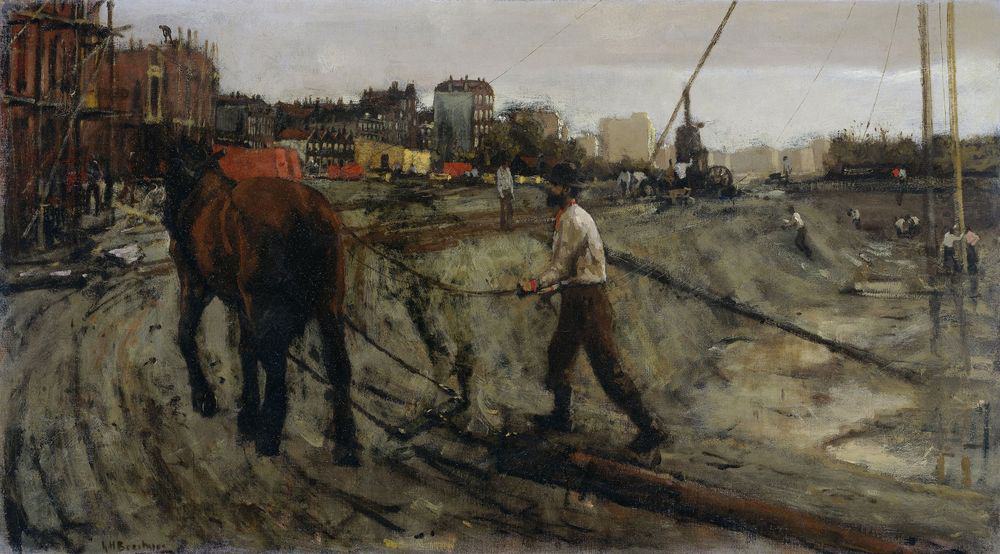
Construction of the canals
In the 17th century, Amsterdam began the systematic construction of canals to improve its connection to the surrounding waterways. The goal was to optimize water transportation facilities, facilitate trade activities and promote urban expansion. These canals became an iconic feature of the city and are a UNESCO World Heritage Site.
Since 1876, the North Sea Canal has provided Amsterdam with a direct connection between the city’s port and the locks at IJmuiden, giving ships access to the North Sea.

The geography of Amsterdam
Amsterdam is the capital of the Netherlands and is located in the western part of the country. Located at the mouth of the Amstel River, the city is characterized by an extensive network of canals. We tell you more.
The location of the city
The capital of the Netherlands is located in the western part of the country. The city lies at the mouth of the Amstel River and is surrounded by a vast network of canals, contributing to its unique urban landscape. Its strategic location on the IJ, a tributary of the Markermeer, has helped Amsterdam grow over the centuries into a major trading center and a hub of international trade and shipping.
The city layout
Amsterdam is divided into several city districts, each with its own character and amenities. The city has a total of 7 boroughs, including the historic center, North, West, New West, South, East, and Southeast. Each district has its own local government responsible for urban development, public facilities and neighborhood initiatives.
The climate in Amsterdam
Amsterdam’s climate is characterized by mild summers and cool winters. It falls in the temperate maritime climate zone, with the influence of the North Sea moderating temperatures. Average maximum summer temperatures are around 22°C, while winter temperatures hover around 2-6°C. Precipitation is possible throughout the year, with a slightly drier period in spring and early summer.
The canals
The canals are an iconic feature of Amsterdam and play an important role in city life. The construction of canals began in the 17th century and they were originally used for transportation, trade and defense. Today, the canals are a tourist attraction and provide a picturesque setting for boat tours and walks along the waterfront. The ring of canals, a network of historic downtown canals, has been recognized as a UNESCO World Heritage Site.
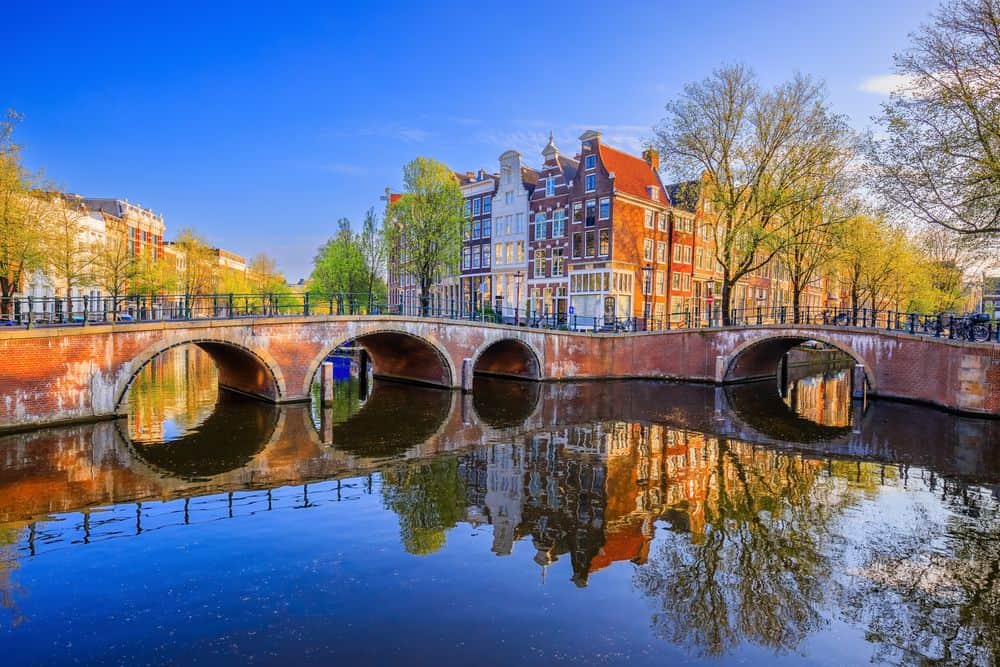
The center
Amsterdam’s historic downtown is the heart of the city and includes many of its most famous landmarks, including Dam Square, the Royal Palace, the Old Church and the Anne Frank House. Here visitors will also find numerous stores, restaurants, museums and entertainment venues. A mix of historic architecture and modern amenities, the city center remains the vibrant center of Amsterdam.
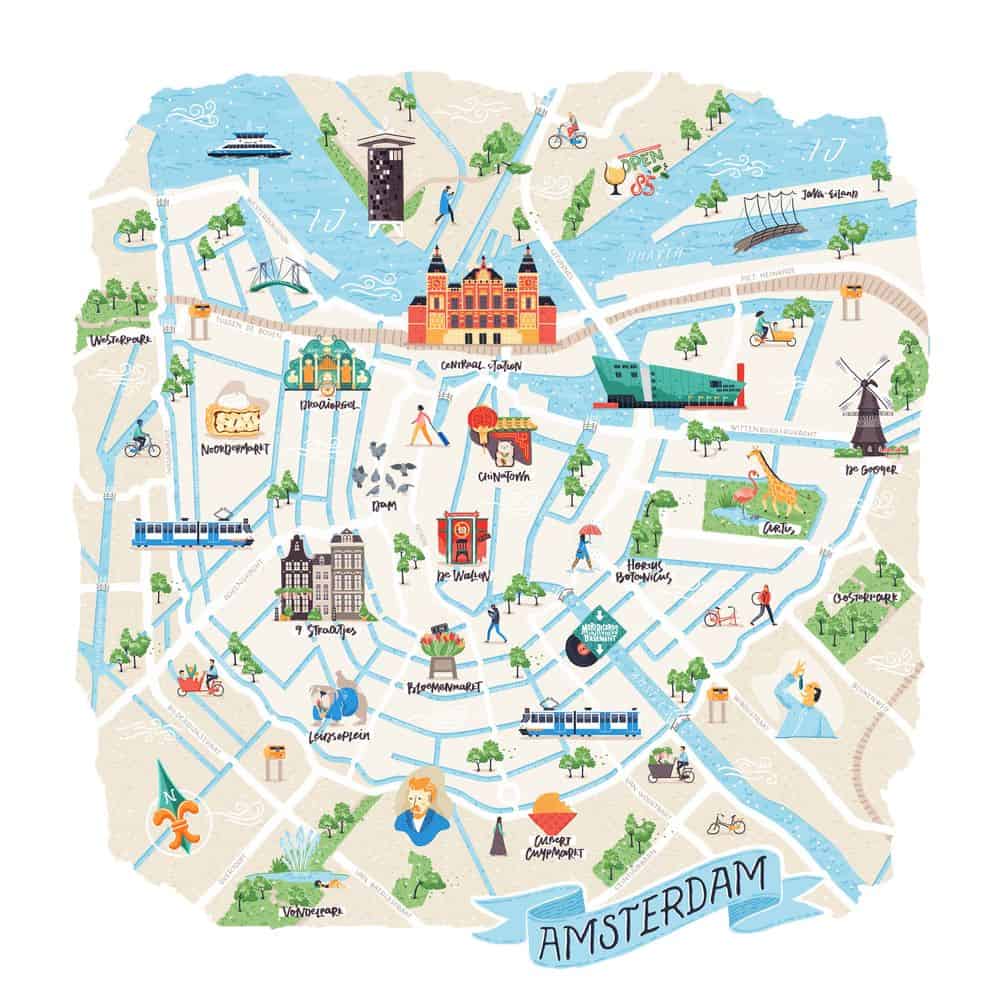
The neighborhoods
Amsterdam has several neighborhoods, each with its own unique character and identity. For example, De Jordaan is known for its picturesque canal houses, art galleries and cozy cafes, while De Pijp is popular for its multicultural atmosphere, lively Albert Cuyp market and Sarphatipark. Each district offers visitors and residents a unique experience and contributes to the city’s cultural diversity.
Parks and areas in Amsterdam
Amsterdam is blessed with many parks and green areas that provide tranquility and relaxation for residents and visitors alike. The Vondelpark, the largest park in the city. It is a popular park for joggers, cyclists and picnickers. Other green spaces include Oosterpark, Westerpark and the Amsterdamse Bos.
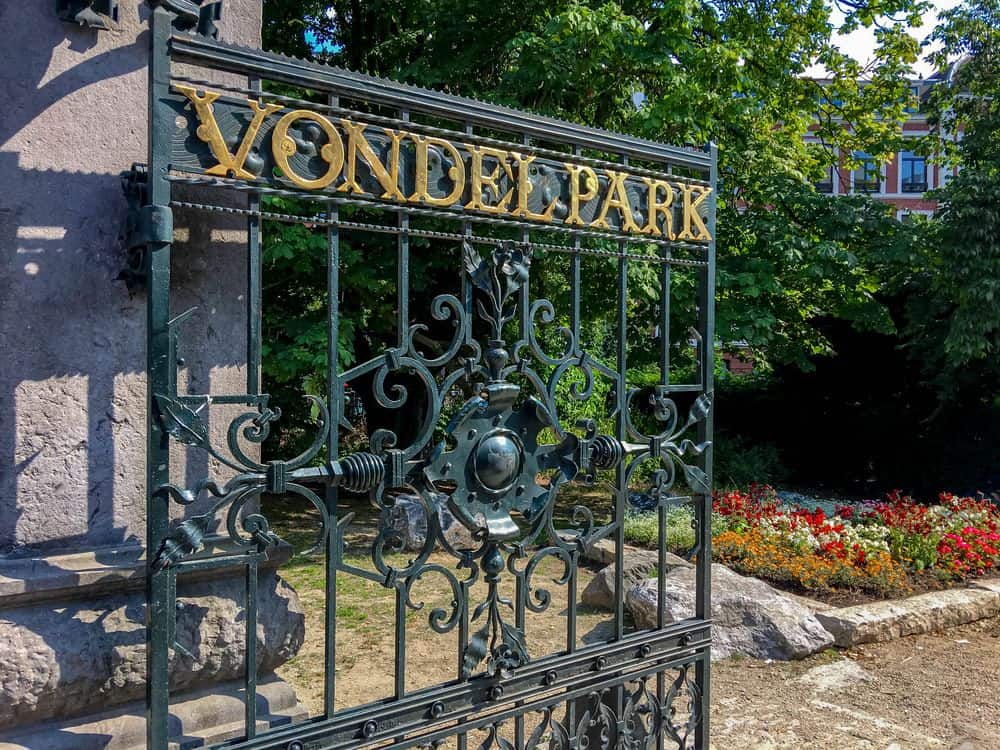
Why is Amsterdam the capital of the Netherlands and not of North Holland?
Amsterdam became the official capital of the Netherlands in the 17th century, when the country was still ruled by the Republic of the Seven United Provinces. Back then, Amsterdam was an important trading center and one of the most prosperous cities in Europe, thanks to the Dutch East India Company and international trade. Although located in the province of North Holland, Amsterdam was chosen as the country’s capital because of its economic power and central role in trade and diplomacy. Since then, Amsterdam has always remained the capital, even though the political centers of power were later moved to The Hague.
The demographics of Amsterdam
Amsterdam’s demographics are diverse and dynamic, with the city being a melting pot of different cultures and nationalities. With a population of more than 800,000, Amsterdam is the largest city in the Netherlands. The city is known for its tolerant and inclusive nature, which has helped attract people from all over the world, making it a vibrant and multicultural metropolis.
How many inhabitants does Amsterdam have?
Now that Weesp has been added to the municipality of Amsterdam with about 21 thousand inhabitants, Amsterdam will have about 903 thousand inhabitants as of March 24, 2022.
The composition of residents in Amsterdam
Amsterdam has a very diverse population with people of different cultural backgrounds and nationalities. There are many immigrants in the city, which has led to a mix of different ethnic groups. The city also has a significant LGBT+ community and a relatively young population.
What religions are there in Amsterdam?
Amsterdam is religiously diverse, with people adhering to different faiths. Most of the population considers themselves non-religious or independent, but adherents of Christianity, Islam, Judaism, Hinduism, Buddhism and other religions can also be found in the city.
What is the residents’ nickname?
The people of Amsterdam are often referred to as “Amsterdammers.” This nickname is used to identify people who live in or originate from Amsterdam.
The dialect of the inhabitants
The Amsterdam dialect, also known as Mokums, is traditionally spoken by residents of the Amsterdam region. Mokums is a variant of Dutch with its own distinctive sounds and words. Although traditional Amsterdamish is spoken less over the years, there are still some local words and expressions used by residents to maintain their identity.
Municipality of Amsterdam
The municipality of Amsterdam is the capital municipality of the Netherlands and is located in the province of North Holland. It includes the city of Amsterdam and surrounding areas. The City of Amsterdam is responsible for the city’s governance and public facilities, and plays a crucial role in maintaining Amsterdam as a vibrant and diverse metropolis.
Politics and governance
Amsterdam’s political and administrative system is run by a city council, a mayor and a college of mayor and aldermen. The City Council is elected every four years by the citizens of Amsterdam and is responsible for setting policy and legislation. The mayor is the city’s figurehead and represents Amsterdam in public affairs, while the College of Mayor and Aldermen handles the day-to-day implementation of policies.
Who is the mayor of Amsterdam?
Femke Halsema is the mayor of Amsterdam. She took office as mayor on July 12, 2018, making her the first female mayor of Amsterdam.
The culture of Amsterdam
Amsterdam’s culture is rich and diverse, with a thriving art scene, historical heritage, vibrant festivals and a tolerant and progressive atmosphere. The city offers a wide range of cultural activities and attractions that attract both residents and visitors, forming Amsterdam’s cultural identity.
Sights and historic buildings
Amsterdam offers an abundance of sights and historic buildings that reflect its rich heritage.
- Canal houses: Amsterdam is known for its beautiful canal houses along the canals that crisscross the city center. These historic buildings date back to the Golden Age and are notable for their typical facades, narrow designs and unique architecture. Many of these properties are well preserved and offer picturesque views of the city’s historic past.
- The Rijksmuseum: This world-renowned museum is one of Amsterdam’s main cultural attractions and houses an extensive collection of art and historical objects. The iconic building itself is an impressive architectural masterpiece that reflects Dutch history and culture in all its glory.
- Anne Frank House: The former hiding place of Jewish girl Anne Frank has now become a memorial site that attracts thousands of visitors each year. The House offers a gripping look at the life and experiences of Anne Frank and her family during World War II.
- Van Gogh Museum: This museum is dedicated to the life and work of famous Dutch artist Vincent van Gogh. Visitors here enjoy an extensive collection of his paintings and letters, giving them insight into his creative genius.
- Royal Palace Amsterdam: Located on Dam Square, this magnificent palace was originally built as the city hall of Amsterdam. Now it is used for official receptions and events of the Royal Family.
- Westerkerk: This Protestant church is one of the most recognizable churches in Amsterdam, with its imposing tower overlooking the city. It is also the final resting place of the painter Rembrandt van Rijn.

Museums in Amsterdam
Amsterdam is a paradise for art and culture lovers, with an abundance of museums covering a wide range of subjects. The famous Van Gogh Museum is a tribute to the life and work of Dutch master Vincent van Gogh, where visitors enjoy his masterpieces and discover how his art developed.
The Rijksmuseum, one of the most prominent museums in the world, houses an extensive collection of works of art and historical artifacts from Dutch history, including masterpieces by Rembrandt and Vermeer.
For lovers of maritime history, the Maritime Museum is a must-see attraction. Located in an impressive 17th-century building, this museum offers a fascinating look at Dutch maritime tradition, with numerous interactive exhibits and even the opportunity to sail past historic ships.
In addition to these well-known museums, there are numerous other interesting and unique museums in Amsterdam, such as the Anne Frank House, the Stedelijk Museum of Modern Art, the Rembrandt House, the NEMO Science Museum and the Tropenmuseum, just to name a few.

Churches
Amsterdam is home to a number of beautiful churches with a rich historical and architectural heritage. The Westerkerk, a Protestant church, is one of the city’s most striking churches, with its imposing tower overlooking the canal belt. It is also the final resting place of the famous painter Rembrandt van Rijn.
Another notable church is the Old Church, located in the heart of the historic center. It is the oldest church in Amsterdam and dates back to the 13th century. Its Gothic architecture and impressive interior make it a unique and atmospheric venue for cultural events and exhibitions.
The Nieuwe Kerk, although no longer in use as an active church, is an important cultural site in Amsterdam.
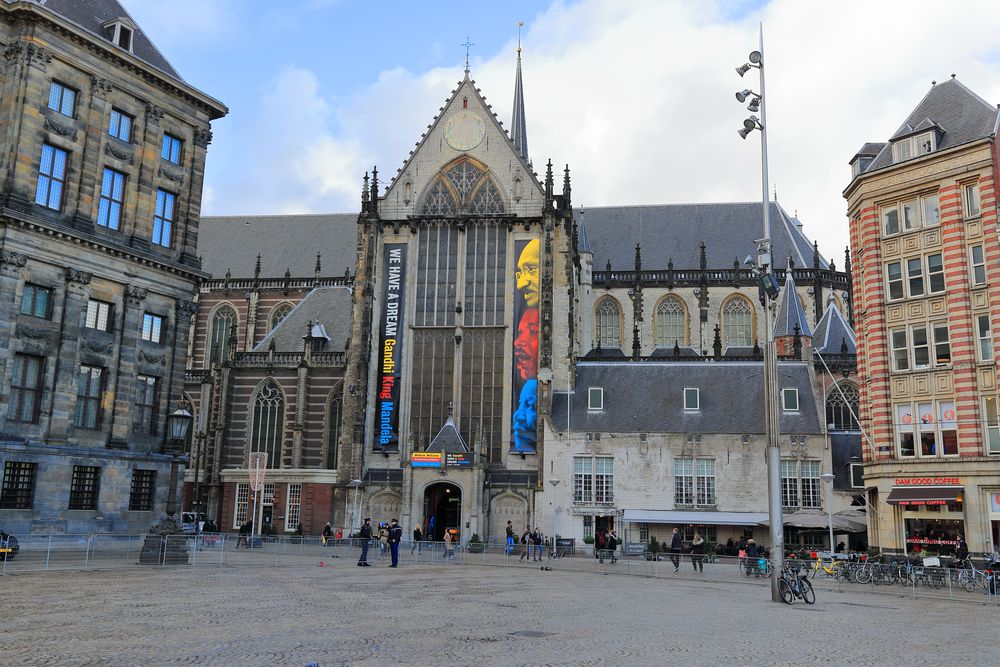
Squares
Amsterdam has several beautiful squares that play an important role in city life and social interaction. Rembrandtplein, named after the famous Dutch painter Rembrandt van Rijn, is a bustling square with numerous restaurants, cafes and entertainment venues. Best known for its vibrant nightlife, it attracts residents and tourists alike.
Leidseplein is another lively square in the heart of Amsterdam. It is known for its diverse cultural offerings, including theaters, cinemas, restaurants and cafes. The square is often the scene of street performers and musicians, giving it a lively and vibrant atmosphere.
Museumplein is a larger square surrounded by important cultural institutions such as the Rijksmuseum, the Van Gogh Museum and the Stedelijk Museum. A popular meeting place for tourists and locals alike, it also provides space for relaxation and recreation in the nearby Vondelpark.
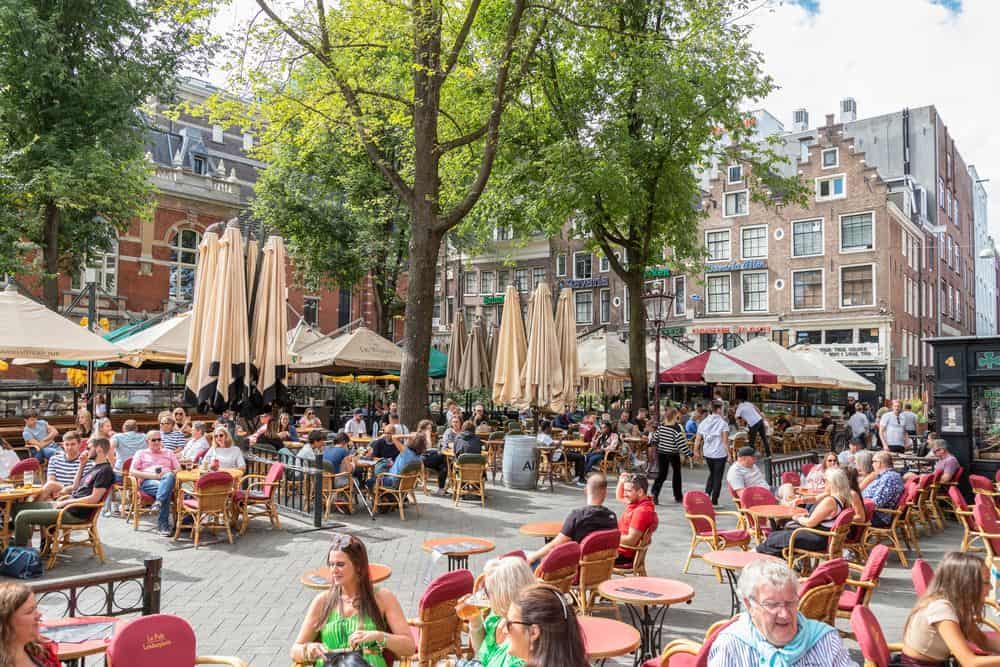
Bridges
Amsterdam is known for its vast network of canals and waterways, spanned by more than 1,500 bridges. These bridges are essential to the city’s infrastructure, allowing pedestrians, cyclists and cars to easily make their way through the cityscape. Some of the most famous bridges include the Skinny Bridge, an iconic double drawbridge over the Amstel River, and the Torensluis, Amsterdam’s oldest surviving bridge, dating back to the 17th century.
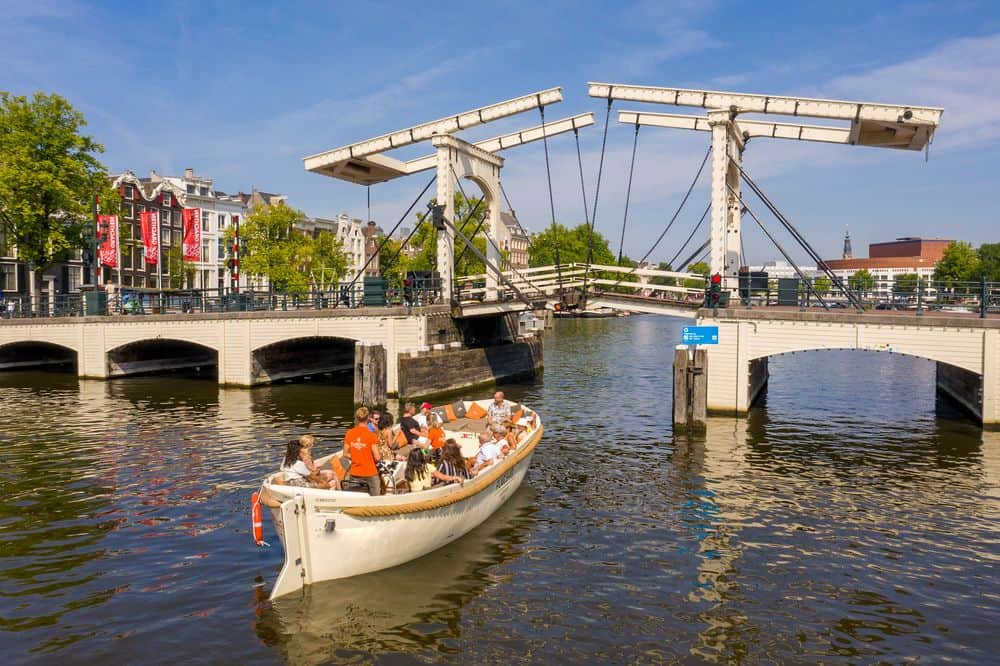
Districts
The Red Light District, also known as the Red Light District, is a famous and controversial neighborhood in the oldest part of Amsterdam. It is known for its narrow streets, old canal houses and the array of prostitution and coffee shops. Despite its reputation, the Red Light District attracts many tourists because of its unique atmosphere and historical character.
The Jordaan is a picturesque and lively neighborhood with narrow streets, canals and cozy cafes and boutiques. Originally a working-class neighborhood, it is now a trendy and popular area where artists and creatives live. The Jordaan also offers a rich history and is the birthplace of many famous Dutch singers and artists.
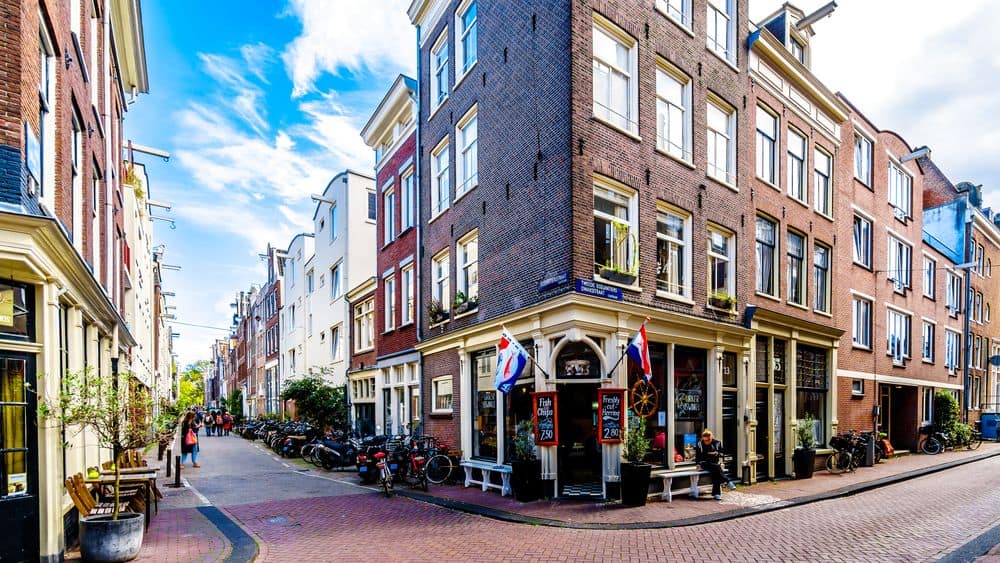
Theaters
Amsterdam has a number of famous theaters! Theater Carré is one of the most famous theaters in Amsterdam, located on the banks of the Amstel River. A historic theater dating back to 1887, it offers a wide range of performances, from plays to musicals and concerts.
The DeLaMar Theater is a modern theater in the heart of Amsterdam, known for its varied program of both national and international productions. The theater offers a modern and elegant setting for theatrical performances and events.
Pathé Tuschinski is a historic Art Deco-style movie theater known for its beautiful architecture and interior. It offers a luxurious movie experience with a diverse selection of films, from blockbusters to art-house productions.

Events in Amsterdam
Amsterdam has several major events, listed below are the most famous ones.
- Kings Day in Amsterdam: Kings Day is celebrated annually on April 27 in honor of the birthday of the King of the Netherlands. Amsterdam is the venue for one of the largest and most vibrant celebrations in the country. The city turns into a sea of orange, with street parties, free markets and events all over the city. Many celebrate King’s Day on boats on the canals, creating a unique and lively atmosphere.
- Amsterdam Light Festival: The Amsterdam Light Festival is an annual light art festival that takes place from late November to late January. During the festival, artworks by light artists from around the world are displayed along Amsterdam’s canals and public spaces. Visitors can take a special boating route to admire the beautiful light installations from the water.
- Pride Amsterdam: Pride Amsterdam is an annual event that takes place the last weekend of July and early August. It is a celebration of the LGBTQ+ community and a fight for equal rights. The festivities include colorful street parades, performances and parties throughout the city, making Amsterdam one of the most tolerant and inclusive cities in the world.

Concerts in Amsterdam:
- Concert aan de Amstel: Concert aan de Amstel is an annual classical music concert that takes place on the Amstel River on the evening of King’s Day. The concert brings together several well-known orchestras and artists and attracts thousands of visitors who enjoy the music and atmosphere.
- Grachtenfestival: The Grachtenfestival is an annual classical music festival that takes place in August. The festival includes concerts at various locations around the city, including on boats in the canals, historic courtyards and famous venues such as the Concertgebouw.
- Liberation Concert: The Liberation Concert takes place annually on May 5 on the Amstel River as part of the celebration of the liberation of the Netherlands in World War II. The concert will be performed by the Royal Concertgebouw Orchestra and other musicians and will be broadcast live on television.
- Prinsengracht Concert: The Prinsengracht Concert is an annual open-air concert that takes place on a floating stage on the Prinsengracht. Organized in August, it attracts thousands of visitors each year who enjoy classical music and a unique atmosphere on the historic canals.
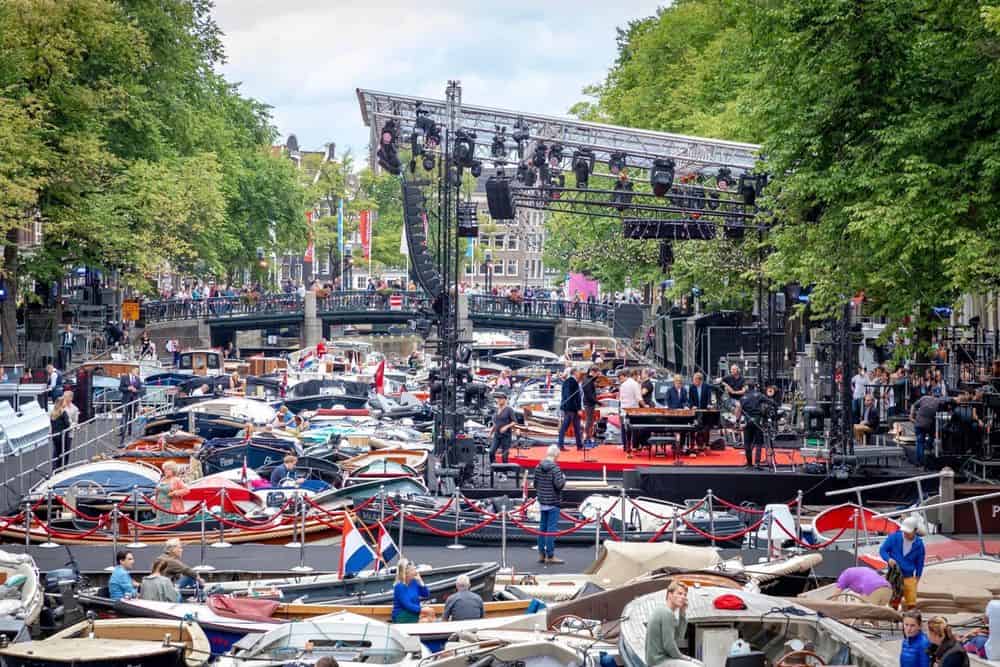
The economy of Amsterdam
Amsterdam’s economy is dynamic and diverse, with a strong emphasis on trade, finance, tourism, creative industries and technology.
What does Amsterdam’s economy look like?
Amsterdam’s economy is diverse and dynamic, with a strong focus on trade, finance, technology and tourism. As a major financial center in Europe, the city attracts numerous international companies and investors. In addition, the technology and creative industries are thriving, with Amsterdam known as a hotbed for start-ups and innovation.
Companies in Amsterdam
Amsterdam’s economy is characterized by a diverse mix of businesses, ranging from large international corporations to small start-ups and creative enterprises. The city has a favorable business climate and is known for its innovative and entrepreneurial spirit. Amsterdam houses important financial institutions, such as the Dutch Bank and the Amsterdam Stock Exchange, making it an important financial center in Europe.

Income in Amsterdam
The average income in Amsterdam is relatively high compared to the rest of the Netherlands. The city offers a wide range of employment opportunities in various sectors, including finance, technology, media, tourism and creative industries. Its high quality of life, good amenities and cultural appeal make Amsterdam an attractive place for residents, students and expats alike.
Stores and markets in Amsterdam
Amsterdam offers a diverse selection of stores and markets, ranging from major shopping streets like Kalverstraat to boutiques in trendy neighborhoods like the Nine Streets. The city is also known for its many markets, such as the Albert Cuyp Market, Dapper Market and Flower Market, where visitors enjoy fresh produce, artisanal goods and unique souvenirs.
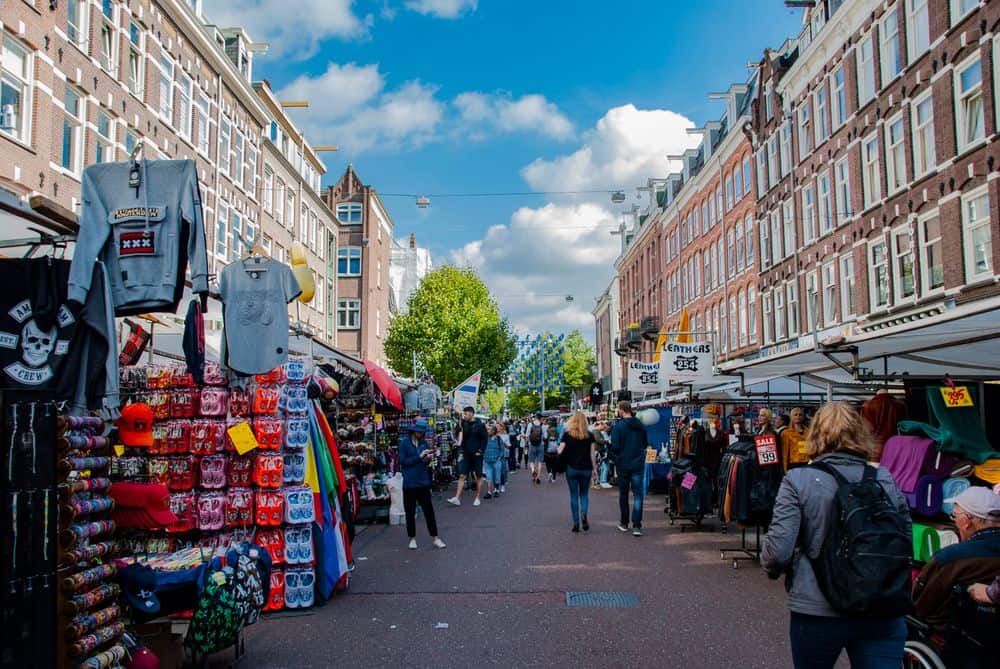
Tourism in Amsterdam
Tourism is an important pillar of Amsterdam’s economy. Every year, the city attracts millions of tourists from all over the world. Visitors come to Amsterdam for its rich history, cultural heritage, world-renowned museums and iconic landmarks. Tourism contributes to employment in the hospitality, retail and cultural sectors, making it an important source of income for the city.
Traffic in and around Amsterdam
Traffic in and around Amsterdam is often challenging because of the busy streets, bike lanes and canals. In addition, Schiphol Airport is an important international hub with an international connection to and from destinations around the world.
Major highways in and around Amsterdam
The main highway in Amsterdam is the A10, also known as the ring road of Amsterdam. This highway forms a ring around the city center and connects different parts of the city. In addition, there are other major highways such as the A1, A2, A4 and A9 that connect Amsterdam to cities in the area and various regions.

Roads running through Amsterdam
The canals and bridges are a distinctive part of the city and are important arteries for cars, cyclists and pedestrians. Traffic in Amsterdam is heavy, especially during rush hours, but the city also encourages the use of bicycles and public transportation as more sustainable alternatives to improve mobility and promote livability.
Railroads in and through Amsterdam
Amsterdam has an extensive rail network with several train stations, including Central Station, the largest and most central station in the city. Central Station is the city’s main train station and provides direct connections to several cities in the Netherlands, such as Rotterdam, Utrecht, and The Hague. Besides Central Station, other stations such as Amsterdam Amstel, Amsterdam Zuid and Amsterdam Sloterdijk support commuter and intercity traffic.
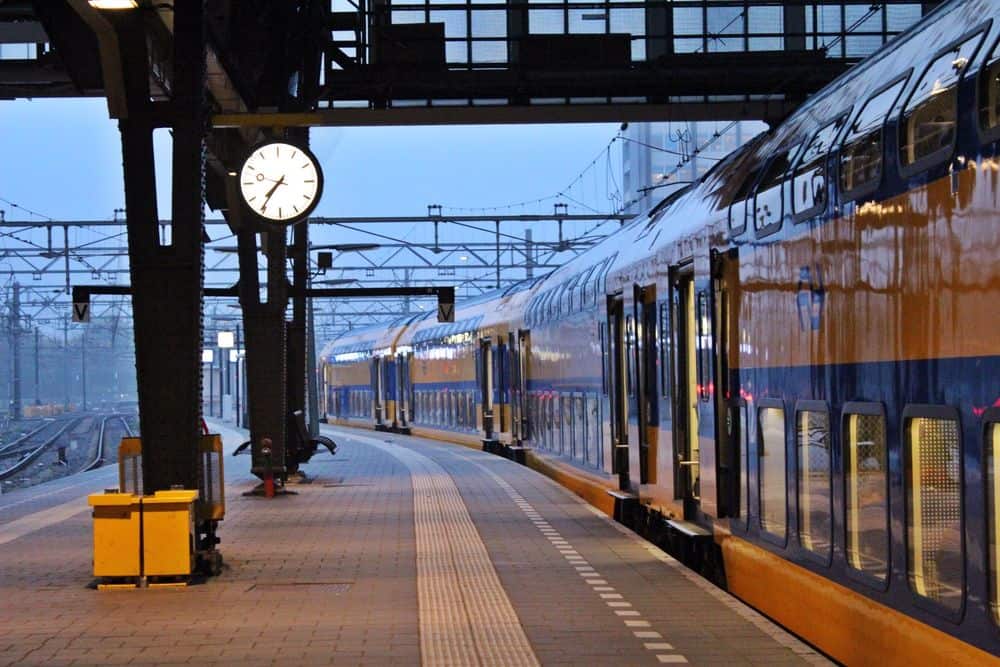
Buses and other transportation in Amsterdam
Amsterdam has an extensive public transportation network, including an extensive bus system and streetcars running throughout the city. The GVB (Gemeentelijk Vervoerbedrijf) is responsible for managing public transportation in Amsterdam and provides a reliable and convenient way to travel around the city. In addition, Amsterdam has a modern subway system that connects different parts of the city, making it easy for residents and tourists to get around.
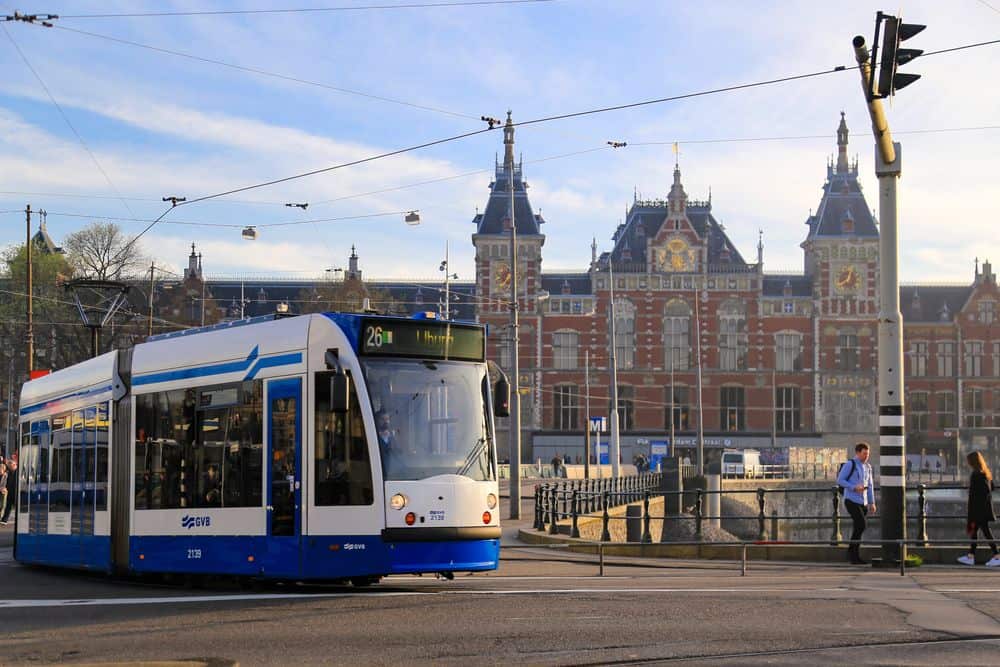
Shipping in Amsterdam
Amsterdam is a city with a rich maritime history and still has a thriving shipping industry. The canals are an iconic feature of the city and are widely used for tourist tours and freight transport. In addition to the canals, the port of Amsterdam is a major hub for international shipping, with modern facilities and a strategic location on the North Sea. Shipping remains an integral part of Amsterdam’s culture and economy, and its preservation is of great importance to the city.
Visiting Amsterdam
Experience a day in Amsterdam full of adventure and culture. Start at the iconic Rijksmuseum and nearby Museum Square for art and history. Then cruise the picturesque canals to admire the city from the water. Afterwards, visit the Anne Frank House for an impressive historical experience. Stroll through the center, enjoy the architecture and stores, and relax in the Vondelpark. A day of discovery and enjoyment in Amsterdam! Wondering what else you can do? Then check out what to do in Amsterdam page.
See more? Then go for a weekend in Amsterdam! Start with a visit to the Van Gogh Museum and discover the famous artist’s masterpieces. Then cycle through the city, explore the lively Jordaan area and visit the lively markets. Enjoy the vibrant nightlife in De Pijp and sample a variety of culinary delights. Head to the atmospheric NDSM area and admire street art and creative hubs. An unforgettable weekend of fun in Amsterdam!



